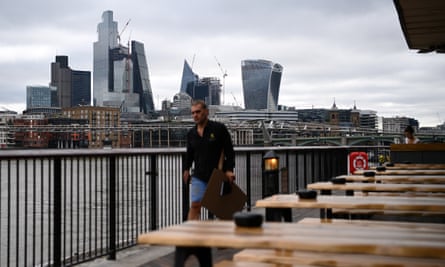The new central London headquarters of the property company CBRE could easily be mistaken for a hotel, given its open lounges with comfy seating, potted plants, coffee and tech bars and library.
In the post-pandemic property world, phrases such as “hotelification” and “earning the commute” have become commonplace among executives trying to lure back workers used to working from home.
Many bosses accept hybrid working is here to stay. Some smaller businesses have abandoned permanent offices altogether.

But with higher borrowing costs, weaker levels of economic growth, and fewer people working in offices in town and city centres after the pandemic, investors fear a perfect storm is brewing in the property sector.
After the collapse of Silicon Valley Bank, the largest banking failure since 2008, and the UBS rescue of Credit Suisse, some City investors are worried the next phase of the crisis could pile pressure on the commercial property market– worth $20tn (£16tn) globally – if banks rein in their lending to the industry.
Last week, the Bank of England increased the base rate for the 11th time in a row to 4.25% as it tries to tame stubbornly high inflation, while the US Federal Reserve raised rates a quarter percentage point to a range of 4.75% to 5%, the highest since 2007. A week earlier, the European Central Bank raised its deposit rate by half a percentage point to 3%.
The chief executive of JP Morgan Asset Management has warned that offices and shops could be the next casualty. “When the Federal Reserve hits the brakes, something goes through the windshield,” George Gatch said on Tuesday. “Commercial real estate is an area of concern. We have higher interest rates for property developers, how does impact the real estate market and lenders in that space?”
The Monday to Friday office occupancy rate across the UK is 29% for 2023 to date, and slightly less in London, compared with typical pre-pandemic levels of 60%-80% according to data from Remit Consulting.
About 40% of UK working adults work from home at least one day a week, according to the latest Office for National Statistics figures, compared with 12% pre-pandemic.
Home working is heavily weighted to Mondays and Fridays, with office occupancy generally higher during the middle of the week.

However, this does not really alter companies’ space requirements – “you just have to accept that [the office is] going to be empty on a Friday,” Simon Brown, the head of UK office research at the US-owned CBRE, says.
He says the central London market is closely linked to international trends and global economic performance, and is much more volatile than other UK cities.
Against this backdrop it is perhaps not surprising that UK commercial property values are sliding . CBRE’s UK monthly index shows commercial values rose in the first half of 2022 but then fell between July and December, wiping out the earlier gains. As a result, property values declined by 13% for the year.
after newsletter promotion
Several property funds, including the Blackstone Real Estate Income Trust, have been forced to limit withdrawals in recent months as investors head for the exit.
Goldman Sachs said in an analysts’ note earlier this month: “The recent stress in the banking sector has fuelled growing concern about spillover effects on the commercial real estate industry.”
“The UK commercial real estate (CRE) debt market seems to be in a better position than the US, where troubled regional banks were the main providers of finance,” Matthew Pointon, a senior property economist at Capital Economics, says. “We are a long way from [great financial crisis] part two.”
The banking system in Britain is very different to the US, where a large share of property loans are advanced by small regional banks. As yet there have been no UK bank failures, and lenders’ exposure to real estate debt is relatively low at 6% of all debt, compared with more than 12% in the run-up to the 2008 financial crisis, he notes.
“That said, credit conditions are also set to tighten in the UK which will make refinancing more of a challenge, particularly for offices where capital values have fallen by 15% since 2018, against an 11% fall for all property,” Pointon says.

Because of rising interest rates, some owners of offices, shops and warehouses may be unable to refinance when existing loans mature, and could be forced to sell assets.
This could deepen the property downturn, and mean the recovery in UK commercial investment – which dipped by £1bn to £61bn in 2022 – will be slower than anticipated. The property group Savills, which reported a drop in annual profits this month, expects the sector to bounce back next year amid a lack of office development supply and a move towards sustainable buildings.
Commercial property prices in the UK could fall by a further 10% this year amid a “downward demand spiral”, Nuwan Goonetilleke, the head of shareholder assets at the savings and pensions group Phoenix Group, says.
Goonetilleke says the outlook for the UK commercial property market, like other business sectors, is closely linked to rising interest rates prompted by runaway inflation. “If inflation continues to rise, we’re going to end up with higher base rates and the chances of a crash increase materially.”
UK inflation unexpectedly rose to 10.4% in February but is expected to fall back later this year. As a result, financial markets forecast that the Bank of England’s cycle of base rate rises is near its peak – which would help dampen fears for the UK commercial property market.









